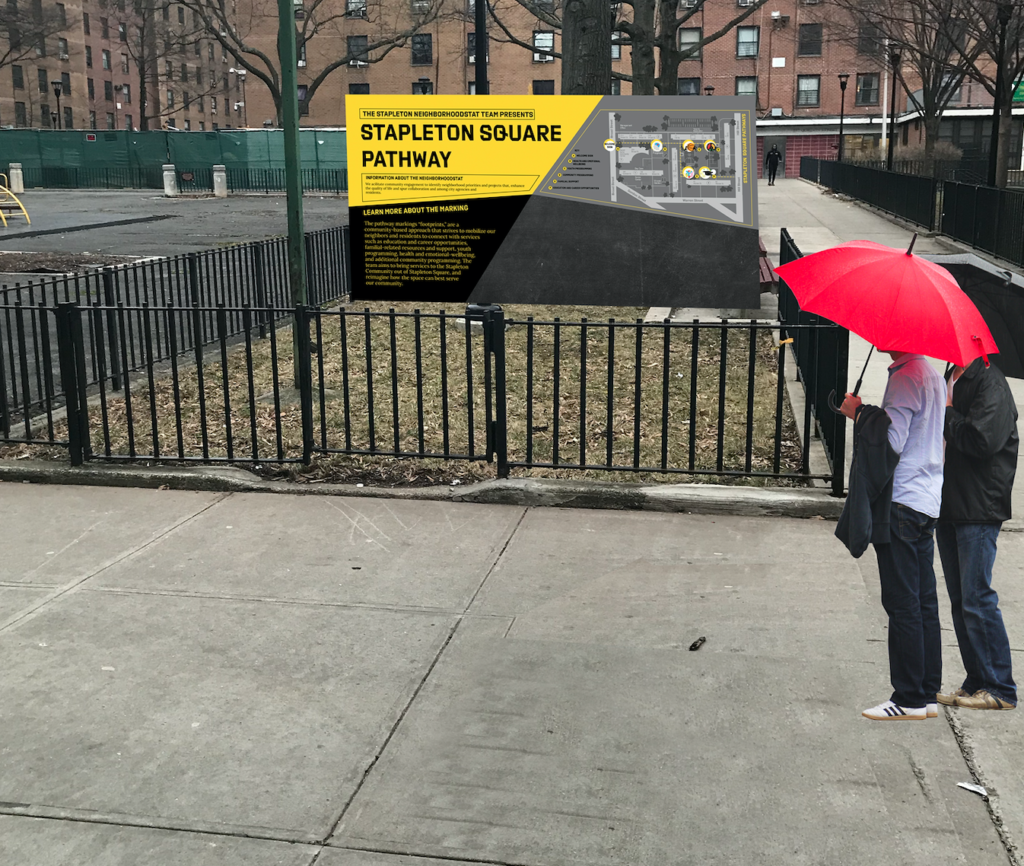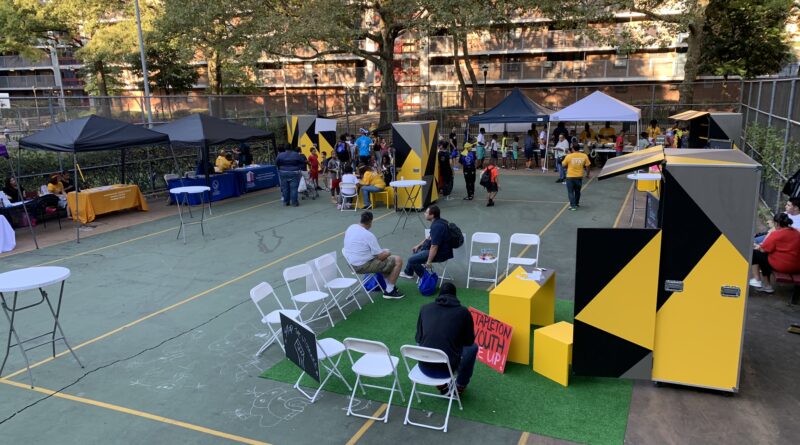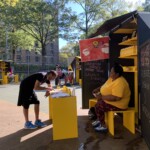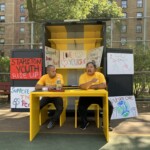Outdoor Space Serves as Community Resources Hub for Stapleton Residents
Residents of Staten Island’s Stapleton Houses may soon notice some brightly colored signs promoting health and wellness, family support, youth programming, and career opportunities while walking the grounds.
The yellow and black directories are not calling attention to self-help services but rather to a dedicated outdoor space where residents can get access to a variety of information on beneficial community resources. Dubbed “Stapleton Square” by a resident stakeholder team, the site is made up of five pop-up mobile kiosks near the development’s tennis court area; it effectively operates as a hub to connect the community to requested services, resources, and programming.
The Resource Hub is a product of the Mayor’s Action Plan for Neighborhood Safety (MAP), a neighborhood-based initiative that aims to increase safety through coordinated crime reduction efforts at 15 NYCHA developments, including Stapleton Houses. With this mission, MAP calls on the residents to help identify key issues underlying crime in their neighborhood and take part in the process to address these community safety priorities.
“The idea is that ultimately residents and partners need to be working together to identify priorities, and working in tandem to improve the conditions that will ultimately create an environment that’s safer and will promote resident well-being,” said Tamara Greenfield, Deputy Executive Director of MAP, which is part of the Mayor’s Office of Criminal Justice.
The resident-centered approach is at the heart of MAP’s NeighborhoodStat process, which brings together residents of the 15 NYCHA properties, community organizations, and City agencies to identify public safety concerns and priorities, create action plans, and implement collaborative solutions to help support a more vibrant community. While priorities have varied at each development, some key issues for Stapleton’s resident stakeholder team have included health and overall wellness, safety and justice, connection to resource information, as well as youth programming and development.
“Connection is a big issue because the Mayor’s Office has access to a variety of resources, and just connecting NYCHA residents to the fact that those resources exist within the city is a huge step in the right direction,” said Delma Palma of NYCHA’s Design Department, which works as a liaison for the hub project.
In seeking to address its residents’ top priorities, Stapleton’s NeighborhoodStat team developed the concept of the Resource Hub, which supports one of the MAP goals to activate community spaces. The Mayor’s Office of Criminal Justice partnered with NYCHA and the nonprofit Center for Court Innovation to establish the pop-up hub in the summer of 2019 in the Stapleton Houses tennis court area, providing an accessible space for residents to receive information and programming related to career opportunities, family support, and overall wellness.
“We thought there had to be a different way to connect our neighbors and residents to a service, program, or resource,” said Leticia Lucero, MAP Engagement Coordinator at Stapleton. “We said, ‘Why don’t we create a space, a central location, where folks can come and get access to all these priorities?’”
Ms. Lucero noted that the project has been well received by the community and that prior to the pandemic, the site also hosted a variety of events with food, games, and entertainment, such as a movie night. In addition to helping bring people together, the hub project has enabled local community organizations and agencies to share the space to promote their own programming and expand the type of resources offered.
“We make sure to not only provide a specific type of programming like MAP does, but to also invite partners to use the kiosks to add onto our hub and make it more diverse and dynamic,” Ms. Lucero said.
The NeighborhoodStat engagement process has also allowed residents of the 15 NYCHA developments to choose how $30,000 in City funding can be used for a project to increase safety at the development. After a voting campaign in which more than 200 responses were collected for five proposals, Stapleton residents selected a recreation space with a new basketball court as their winning project.
Further bolstering the resident stakeholder team’s activities is the effort to install signage at specific areas of the Stapleton development that will serve as a wayfinding tool to provide information about the hub project and promote future program opportunities. The six yellow and black signs, along with previously placed pathway markings, are intended to draw visibility for the Resource Hub, foster connectivity within the development, and encourage pedestrian traffic to the site.
“It’s another way to connect our partners and the neighbors to the resources,” Ms. Lucero said of the soon-to-be-installed signs.

Ms. Palma noted: “The engagement efforts are leading to layers of change in the open spaces of the development, as well as empowering the residents with stronger connection and a sense of ownership towards the open spaces in their homes. And building towards such a shift is at the very core of the intent of NYCHA’s Connected Communities initiative.”
Ms. Greenfield called the Resource Hub effort a “tremendously creative project,” which has been elevated by the residents who have worked to generate awareness and bring dynamic solutions to help create a safer environment for the Stapleton community.
“This is a project that really came out of the creativity and vision of the residents, without a lot of precedent, which is really exciting,” she said.
Photo caption: This pre-COVID-19 photo shows the Resource Hub area with pop-up mobile kiosks on the tennis court at Staten Island’s Stapleton Houses.









